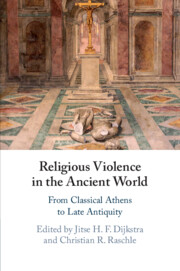Book contents
- Religious Violence in the Ancient World
- Religious Violence in the Ancient World
- Copyright page
- Contents
- Acknowledgements
- List of Contributors
- A Note on Abbreviations
- General Introduction
- Part I Methodology
- Part II Religious Violence in the Graeco-Roman World
- Part III Religious Violence in Late Antiquity
- Chapter 10 Religious Violence in Late Antiquity: Current Approaches, Trends and Issues
- Chapter 11 Coercion in Late Antiquity: A Brief Intellectual History
- Chapter 12 Crowd Behaviour and the Destruction of the Serapeum at Alexandria in 391/392 ce
- Chapter 13 Violence and Monks: From a Mystical Concept to an Intolerant Practice (Fourth to Fifth Century)
- Chapter 14 The Discipline of Domination: Asceticism, Violence and Monastic Curses in Theodoret’s Historia Religiosa
- Chapter 15 Suffering Saints: Shaping Narratives of Violence after Chalcedon
- Chapter 16 Fighting for Chalcedon: Vitalian’s Rebellion against Anastasius
- Chapter 17 The Emperor, the People and Urban Violence in the Fifth and Sixth Centuries
- Index of Sources
- General Index
Chapter 13 - Violence and Monks: From a Mystical Concept to an Intolerant Practice (Fourth to Fifth Century)
from Part III - Religious Violence in Late Antiquity
Published online by Cambridge University Press: 18 September 2020
- Religious Violence in the Ancient World
- Religious Violence in the Ancient World
- Copyright page
- Contents
- Acknowledgements
- List of Contributors
- A Note on Abbreviations
- General Introduction
- Part I Methodology
- Part II Religious Violence in the Graeco-Roman World
- Part III Religious Violence in Late Antiquity
- Chapter 10 Religious Violence in Late Antiquity: Current Approaches, Trends and Issues
- Chapter 11 Coercion in Late Antiquity: A Brief Intellectual History
- Chapter 12 Crowd Behaviour and the Destruction of the Serapeum at Alexandria in 391/392 ce
- Chapter 13 Violence and Monks: From a Mystical Concept to an Intolerant Practice (Fourth to Fifth Century)
- Chapter 14 The Discipline of Domination: Asceticism, Violence and Monastic Curses in Theodoret’s Historia Religiosa
- Chapter 15 Suffering Saints: Shaping Narratives of Violence after Chalcedon
- Chapter 16 Fighting for Chalcedon: Vitalian’s Rebellion against Anastasius
- Chapter 17 The Emperor, the People and Urban Violence in the Fifth and Sixth Centuries
- Index of Sources
- General Index
Summary
In its early days, monasticism went hand in hand with several manifestations of violence. While it is true that the semantic scope of the word ‘violence’ and the concept that it evokes need to be defined,1 there is still a premise that we cannot afford to disregard: the literary sources contain a significant number of passages in which violence occurs in the literal sense, which will be taken here as ‘the use of physical force against an opponent’. In the accounts preserved about the first monks, this violence appears to have been used against adherents of other cults (in the context of an opposition between Christianity and paganism),2 or against people from Christian movements different from the one to which the protagonist belongs and vice versa (in cases where there was an intra-Christian conflict between Nicaeans and Arians, or between Chalcedonians and miaphysites);3 it may also be exerted on objects of worship or sacred buildings of non-Christians,4 which, as has recently been argued, may have acted as a safety valve against a more serious aggravation of hostilities.5 Finally, within the more restricted framework of monastic life, violence could be employed against those who disobeyed the precepts of the master or challenged his authority and, by doing so, adopted an attitude of religious dissent.6
- Type
- Chapter
- Information
- Religious Violence in the Ancient WorldFrom Classical Athens to Late Antiquity, pp. 306 - 322Publisher: Cambridge University PressPrint publication year: 2020

